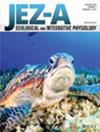过度拥挤介导的应激改变了砂鼻草幼虫发育过程中关键神经内分泌区域的细胞增殖。
IF 2.8
3区 生物学
Q2 Agricultural and Biological Sciences
Journal of experimental zoology. Part A, Ecological genetics and physiology
Pub Date : 2016-02-01
DOI:10.1002/jez.2005
引用次数: 4
摘要
暴露在不利的环境条件下会引起应激反应,从而导致内源性皮质酮水平的增加。在生命的早期阶段,已经有充分的证据表明,慢性应激通过干扰变质过程改变了两栖动物幼虫的生长和发育,然而,所涉及的潜在机制只被部分解开。我们研究了种在种内竞争对沙蟾蜍Rhinella arenarum幼虫发育过程中皮质酮水平的影响,以及它对特定脑区和脑垂体细胞增殖的最终影响。虽然过度拥挤改变了脑垂体、下丘脑和大脑第三脑室中增殖细胞的数量,但在与神经内分泌过程联系较少的区域,如大脑第一脑室,没有观察到差异。下丘脑细胞凋亡增加,垂体细胞凋亡未见增加。在过度拥挤的幼虫中,垂体细胞数量减少的是促甲状腺细胞,而不是生长萎缩细胞和促皮质细胞。我们的研究表明,由压力引起的生长和发育的改变,是由神经内分泌系统的不平衡引起的,而神经内分泌系统与变态时间的协调有关。本文章由计算机程序翻译,如有差异,请以英文原文为准。
Overcrowding-mediated stress alters cell proliferation in key neuroendocrine areas during larval development in Rhinella arenarum.
Exposure to adverse environmental conditions can elicit a stress response, which results in an increase in endogenous corticosterone levels. In early life stages, it has been thoroughly demonstrated that amphibian larval growth and development is altered as a consequence of chronic stress by interfering with the metamorphic process, however, the underlying mechanisms involved have only been partially disentangled. We examined the effect of intraspecific competition on corticosterone levels during larval development of the toad Rhinella arenarum and its ultimate effects on cell proliferation in particular brain areas as well as the pituitary gland. While overcrowding altered the number of proliferating cells in the pituitary gland, hypothalamus, and third ventricle of the brain, no differences were observed in areas which are less associated with neuroendocrine processes, such as the first ventricle of the brain. Apoptosis was increased in hypothalamic regions but not in the pituitary. With regards to pituitary cell populations, thyrotrophs but not somatoatrophs and corticotrophs showed a decrease in the cell number in overcrowded larvae. Our study shows that alterations in growth and development, produced by stress, results from an imbalance in the neuroendocrine systems implicated in orchestrating the timing of metamorphosis.
求助全文
通过发布文献求助,成功后即可免费获取论文全文。
去求助
来源期刊
CiteScore
1.29
自引率
3.60%
发文量
0
审稿时长
6-12 weeks
期刊介绍:
The Journal Journal of Experimental Zoology Part A: Ecological Genetics and Physiology publishes articles at the three-way interface between Physiology, Ecology and Evolutionary Genetics. Contributions that help to elucidate how molecular, functional and ecological variation relate to one another are particularly welcome. The Journal publishes original research in the form of rapid communications or regular research articles, as well as perspectives and reviews on topics pertaining to the scope of the Journal. Acceptable articles are not limited to studies on animals, but also include research on plants and microbes.

 求助内容:
求助内容: 应助结果提醒方式:
应助结果提醒方式:


